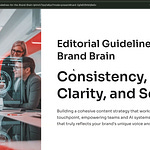This week, I released a little eBook: Pipes Before the Chocolate.
The goal was to serve as a high-level overview of how AI can fit ethically into a Go-to-Market motion. By “ethically,” I mean how AI can help create content that is accurate, clear, and high-quality (as defined by the company we’re helping, since everyone and their mother has a different view of “quality”).
If you’ve been wrestling with where AI fits into your B2B marketing mix—wondering how to speed up content without watering it down—this one’s for you.
Above you’ll find a video laying out the four core phases of any text-based content workflow, and below you’ll find the text-based recap.
Why This Process Matters for B2B Marketers
AI promises faster turnaround, lower costs, and even better personalization—but only if you integrate it thoughtfully.
Siloed “task” approaches (e.g., “Hey AI, write me a blog post”) lead to generic, off-brand drafts. It’s why you feel like you’re working with an untrained intern from Fiverr every time you use ChatGPT.
Instead, treat content creation as a process with distinct stages—strategy, drafting, editing, distribution—and automate selectively to amplify both speed and quality.
The Four Phases of Content Creation
Every piece of content—whether it’s an SEO blog, a sales email, or a landing page—necessarily goes through these four stages:
Strategy
Good Strategy: What & Who? At a minimum, answer what you’re creating and who it’s for.
Great Strategy: Why, Where & When? Great strategy drills into purpose (“Why are we making this?”), channel (“Where will it live?”), and timing (“When should it go out?”).
Best Strategy: AI’s Role: Use tools like keyword planners (e.g., SEMrush, Ahrefs) enhanced with AI insights to identify trending topics and audience pain points in seconds.
Drafting
Human-Only (Old Way): 5–10 business days and ~$2,000 for a top-of-funnel blog post.
AI-Powered (New Way): Generate a first draft in 5 minutes based on a content brief + keyword inputs.
Tip: Feed your AI workflow detailed brand context—tone, style guidelines, audience personas—so drafts are already on-brand from the start.
Editing
TOFU vs. MOFU vs. BOFU: Top-of-funnel needs SEO optimization, accuracy, and clarity checks; middle-of-funnel demands insight and engagement; bottom-of-funnel requires precision and clarity.
Tools in Tandem: Combine Grammarly or Hemingway for grammar, ClearScope or Surfer SEO for topical authority, and AI annotation workflows that highlight suggested edits.
Human In-The-Loop: Editors focus on nuance—adding case studies, tightening messaging, and ensuring brand voice resonates.
Distribution
Smart Scheduling: Use AI-driven social tools (e.g., Buffer’s AI suggestions) or CMS plugins that auto-suggest optimal publish times.
Personalization at Scale: AI can tailor snippets for LinkedIn, Twitter, email subject lines, and more, all drawn from a single content source.
Common Pitfalls & How to Avoid Them
Generic AI Outputs
Fix: Always load brand-specific context into your AI prompts. If your AI doesn’t know your voice, it can’t write it.
Over-Automation
Fix: Reserve AI for tasks that don’t need deep empathy or strategic insight—drafting, data analysis, routine social scheduling. Keep humans in charge of storytelling, brand cohesion, and final approvals.
Data Blind Spots
Fix: Integrate AI analytics into your workflow. Continuously monitor performance metrics—bounce rates, time on page, conversion lifts—and feed that data back into your AI prompts for smarter iterations.
Your Actionable Playbook
Map Your Workflow
Draw a simple flowchart of your strategy → drafting → editing → distribution. Mark which steps are manual and where AI could help.
Pick Your First Pilot
Drafting is low-risk and high-reward. Try generating a blog outline or first draft using an AI tool, then measure time saved versus your typical process.
Build an AI Prompt Library
Create premade prompts that include brand voice, target audience, and SEO keywords. Store these in a shared doc for your team.
Train & Upskill Your Team
Host a workshop on AI tools: show writers how to refine AI outputs, and teach editors to use AI annotation features.
Iterate & Measure
After each content cycle, review key metrics. Adjust your AI prompts and tool settings based on what worked (higher CTRs, longer sessions) and what didn’t.
Looking Ahead
AI will only get smarter. Next up in this guided course: modern SEO and ChatSearch Optimization.
Thanks for reading—and for being part of the evolving world of AI-driven B2B marketing. Hit reply with your biggest AI-workflow challenge, and let’s keep this conversation going. In future issues, we’ll dive into:
Crafting custom AI prompts for niche audiences
Automating event-to-content pipelines (webinars → blogs → social)
Advanced chat-search optimization strategies
Until next time,
— Nathan.ai










